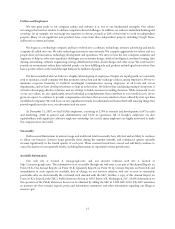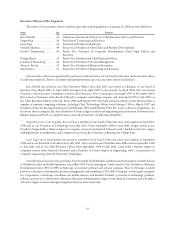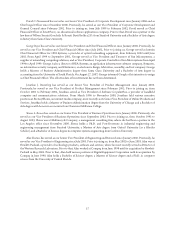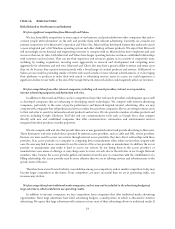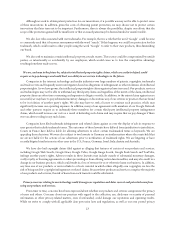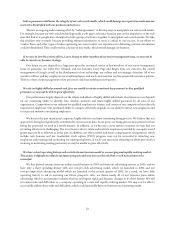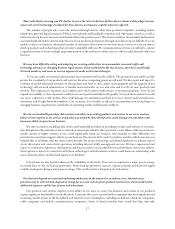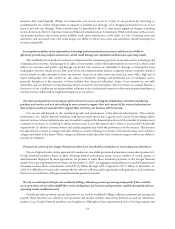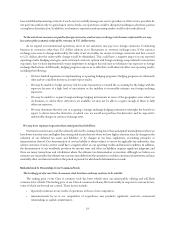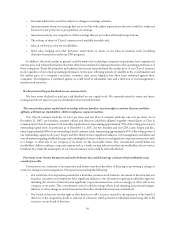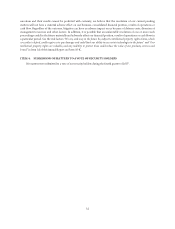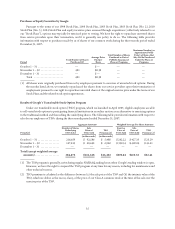Google 2007 Annual Report Download - page 39
Download and view the complete annual report
Please find page 39 of the 2007 Google annual report below. You can navigate through the pages in the report by either clicking on the pages listed below, or by using the keyword search tool below to find specific information within the annual report.Our business may be adversely affected by malicious applications that interfere with, or exploit security flaws in, our
products and services.
Our business may be adversely affected by malicious applications that make changes to our users’ computers and
interfere with the Google experience. These applications have in the past attempted, and may in the future attempt, to
change our users’ internet experience, including hijacking queries to Google.com, altering or replacing Google search
results, or otherwise interfering with our ability to connect with our users. The interference often occurs without
disclosure to or consent from users, resulting in a negative experience that users may associate with Google. These
applications may be difficult or impossible to uninstall or disable, may reinstall themselves and may circumvent other
applications’ efforts to block or remove them. In addition, we offer a number of products and services that our users
download to their computers or that they rely on to store information and transmit information to others over the
internet. These products and services are subject to attack by viruses, worms and other malicious software programs,
which could jeopardize the security of information stored in a user’s computer or in our computer systems and networks.
The ability to reach users and provide them with a superior experience is critical to our success. If our efforts to combat
these malicious applications are unsuccessful, or if our products and services have actual or perceived vulnerabilities, our
reputation may be harmed and our user traffic could decline, which would damage our business.
Proprietary document formats may limit the effectiveness of our search technology by preventing our technology from
accessing the content of documents in such formats, which could limit the effectiveness of our products and services.
A large amount of information on the internet is provided in proprietary document formats such as Microsoft Word.
The providers of the software application used to create these documents could engineer the document format to prevent
or interfere with our ability to access the document contents with our search technology. This would mean that the
document contents would not be included in our search results even if the contents were directly relevant to a search. The
software providers may also seek to require us to pay them royalties in exchange for giving us the ability to search
documents in their format. If the software provider also competes with us in the search business, they may give their
search technology a preferential ability to search documents in their proprietary format. Any of these results could harm
our brand and our operating results.
New technologies could block our ads, which would harm our business.
Technologies may be developed that can block the display of our ads. Most of our revenues are derived from fees
paid to us by advertisers in connection with the display of ads on web pages. As a result, ad-blocking technology could, in
the future, adversely affect our operating results.
If we fail to detect click fraud or other invalid clicks, we could face additional litigation as well as lose the confidence
of our advertisers, which would cause our business to suffer.
We are exposed to the risk of fraudulent clicks and other invalid clicks on our ads from a variety of potential sources.
We have regularly refunded fees that our advertisers have paid to us that were later attributed to click fraud and other
invalid clicks, and we expect to do so in the future. Invalid clicks are clicks that we have determined are not intended by the
user to link to the underlying content, such as inadvertent clicks on the same ad twice and clicks resulting from click fraud.
Click fraud occurs when a user intentionally clicks on a Google AdWords ad displayed on a web site for a reason other
than to view the underlying content. If we are unable to stop these invalid clicks, these refunds may increase. If we find
new evidence of past invalid clicks we may issue refunds retroactively of amounts previously paid to our Google Network
members. This would negatively affect our profitability, and these invalid clicks could hurt our brand. If invalid clicks are
not detected, the affected advertisers may experience a reduced return on their investment in our advertising programs
because the invalid clicks will not lead to potential revenue for the advertisers. This could lead the advertisers to become
dissatisfied with our advertising programs, which has led to litigation alleging click fraud and could lead to further
litigation, as well as to a loss of advertisers and revenues.
25


